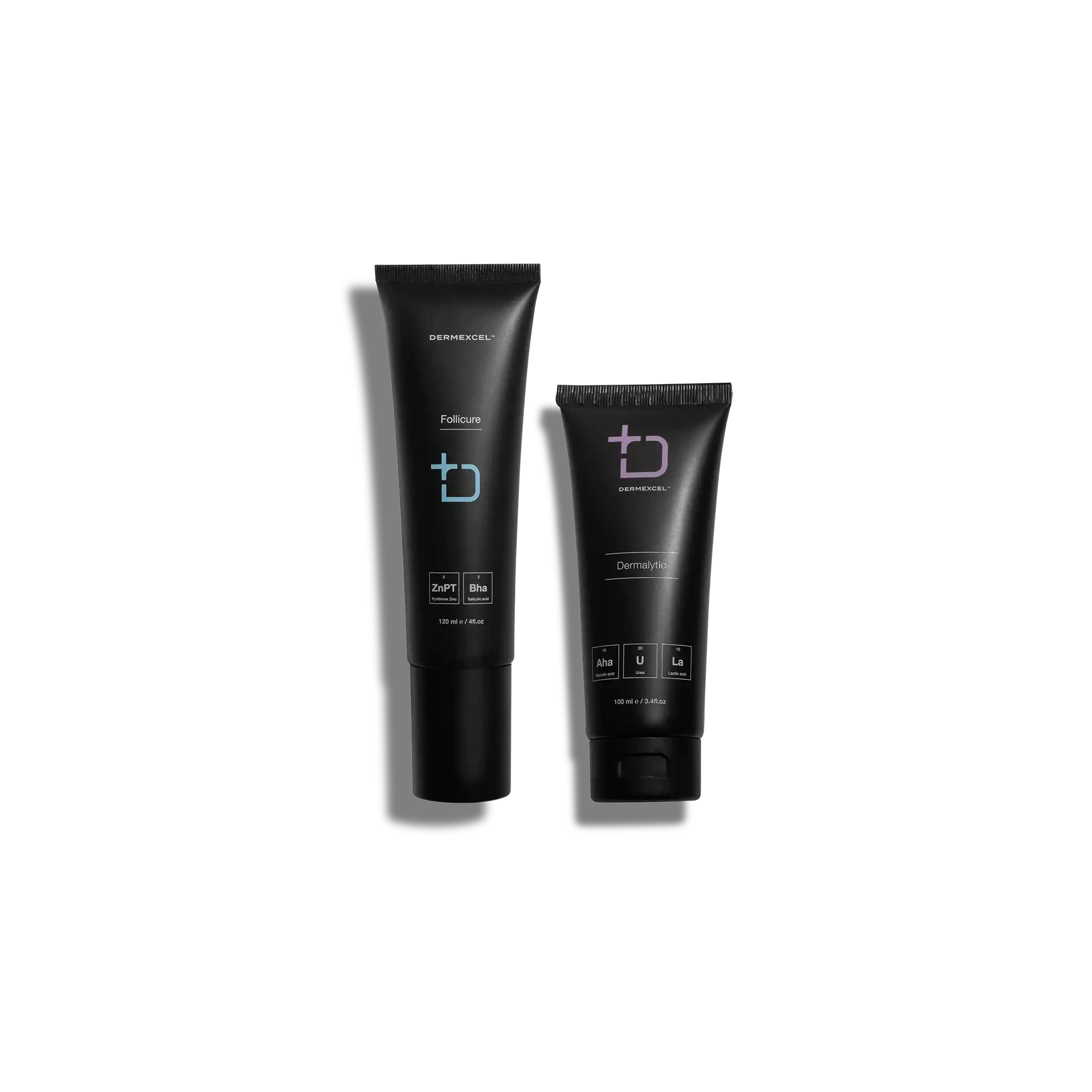
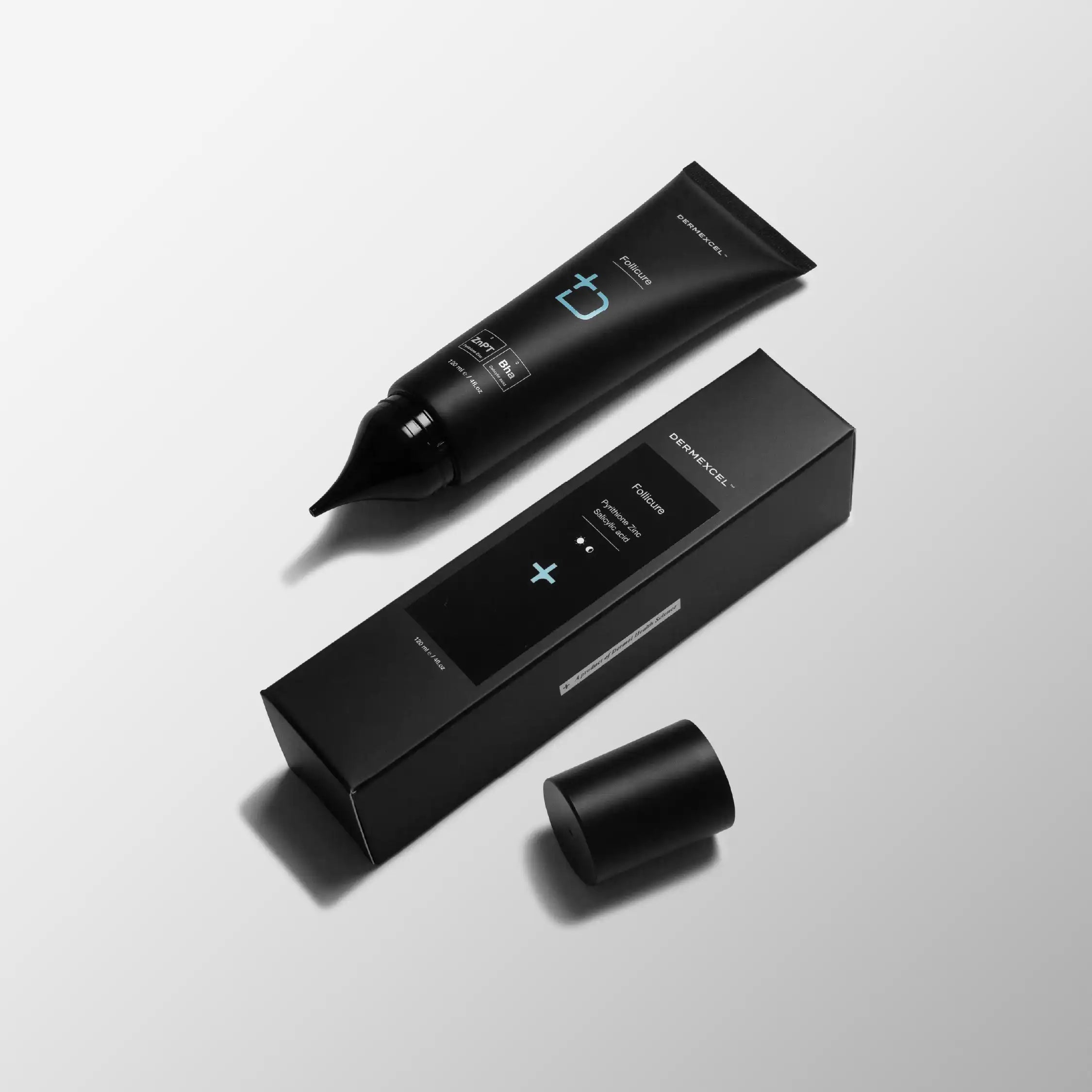




Treatment Pack for Mild Body Keratosis Pilaris

Skin Smoothing

Moisturizing

Anti-microbial

Unclog Pores

↓ inflammation
Products included
Free Gifts with your treatment pack

Cotton Bag

Mini Silicone Scalp Massager




SHIPPING
- Shipping Guarantee: Guiding you to healthy skin isn’t only about our products; it's also about getting them to you as swiftly as the science behind them. That's why Dermal Health offers a shipping guarantee you can rely on.
- Where We Ship From: Orders are dispatched from our facilities in Pretoria.
- Who We Ship With: We trust only well-known, popular, and dependable courier services with your packages.
- When You'll Get It: Expect confident skin soon! Shipping addresses in Pretoria and Johannesburg will enjoy delivery from same-day to 2 business days. Shipping addresses further from Pretoria may expect delivery within 1-4 business days, depending on the service you select during checkout. Your estimated delivery date will reflect during checkout so that you can mark your calendar.
- Tracking Your Order: Eager to start your DermExcel journey? We don't blame you! You'll receive a tracking number after you place your order so that you can follow your package.
For any shipping inquiries, our customer service team is ready to assist.
RETURNS
We are passionate about guiding you to healthier skin through medical science. We believe in the quality and proven effectiveness of our formulations — and we’re committed to supporting you on your journey to real, visible results.
That’s why we offer a 30-Day Confidence Guarantee. If, after consistent use as directed, you genuinely feel that your skin has not improved in any meaningful way — and you can demonstrate this (for example, with before-and-after photos or a brief description of your experience) — you’re welcome to request a return within 30 days of receiving your order, in line with our return policy.
Healthy skin is not complicated — and neither is our return process. To view the full terms, please visit our detailed return policy or contact our friendly customer care team. We’re here to help.
Feel as confident in us as we want you to feel in your skin.
SECURE PAYMENT
Dermal Health Science 30-Day Confidence Guarantee: We are passionate about guiding you to healthy skin through medical science. We believe in the quality and effectiveness of our products so much that we offer a 30-Day Confidence Guarantee.
If you're unsatisfied with your purchase, simply return it within 30 days for a full refund.
Healthy Skin Is Not Complicated and neither is our return policy. Please visit our detailed return policy or contact our friendly customer service team for more information.
Feel as confident in us as we want you to feel in your skin.

Choose options


Treatment Pack for Mild Body Keratosis Pilaris
MORNING
EVENING
MORNING
EVENING
Morning Regimen Notes
- Apply Follicure to affected areas on dry skin, leave on for 5-10 minutes and remove with microfibre sponge.
- Apply your Folicure in the morning and/ or evening.
Evening Regimen Notes
- Apply Follicure to affected areas on dry skin, leave on for 5-10 minutes and remove with microfibre sponge.
- Apply Folicure in the morning and/ or evening.
- Apply Dermalytic to affected areas after cleansing.
- Start using Dermalytic one evening a week after cleansing.
- If your skin adjusts well, you can increase the frequency of use to 2-3 times per week.
In the evenings, you apply Dermalytic; don't layer it with another product. Other products can make Dermalytic less effective by changing its pH.
Important Notes
- Reduce the use of Dermalytic to one evening a week or even one evening every two weeks.
- When irritation subsides, slowly increase the frequency of use again, as tolerated by your skin.
The DermExcel Keratosis Pilaris Treatment Pack encompasses a synergistic duo of products designed to address specific facets of Keratosis Pilaris (KP), a condition known for its rough, scaly skin patches.
Firstly, Follicure embodies the antimicrobial power of 2% Zinc Pyrithione. This ingredient is known for its efficacy against Malassezia yeast, often implicated in exacerbating skin conditions, thus providing a targeted approach towards skin cleansing in KP management.
Secondly, the Dermalytic, a potent keratolytic and intense moisturizer, comprises an emollient and occlusive blend supplemented with Glycolic acid, Lactic acid, and Urea. Together, these ingredients help dissolve keratin plugs and moisturize the skin. Glycolic and Lactic acid serve as alpha-hydroxy acids, promoting exfoliation of the skin's outermost layer. Urea acts as a humectant, attracting moisture to the skin and aiding in keratin dissolution.
The DermExcel Keratosis Pilaris Treatment Pack is a comprehensive, multi-pronged solution for KP management. It focuses on reducing keratin plug formation, alleviating inflammation, and restoring skin's natural softness.
Keratosis Pilaris Treatment Pack
Treatment Objectives

Dissolve Keratin Plugs
One of the key characteristics of Keratosis Pilaris is the formation of keratin plugs that lead to the appearance of small, rough bumps on the skin. Effective treatment aims to dissolve these keratin plugs.

Prevent Complications
Keratosis Pilaris can lead to complications such as skin discoloration and secondary infections caused by scratching. The treatment aims to manage the symptoms effectively to prevent these complications.

Reduce Redness
In some cases, Keratosis Pilaris can cause redness or inflammation in the affected area. The treatment may aim to reduce these symptoms.

Prevention of Recurrence
While Keratosis Pilaris is a chronic condition, the goal of ongoing treatment is to prevent or minimize the frequency of flare-ups.

Moisturize
Maintaining skin hydration can help soften the skin and reduce the appearance of keratosis pilaris by alleviating dryness and minimizing the buildup of keratin that blocks hair follicles.

Exfoliate and smooth skin texture
Since Keratosis Pilaris is caused by a buildup of keratin that blocks hair follicles, one of the main goals is to promote exfoliation. This helps to remove the excess keratin and unclog the hair follicles.
Keratosis Pilaris Treatment Pack
beneficial active ingredients
Glycolic acid
Glycolic acid is highly acclaimed for its remarkable exfoliating and rejuvenating properties. Its small molecular size enables deep skin penetration, fostering efficient exfoliation at the cellular level.
Glycolic acid’s water solubility allows it to penetrate the upper layers of the skin easily. Its primary mechanism of action involves weakening the bonds between dead skin cells, promoting their shedding, and revealing the newer, healthier skin beneath. This process of accelerated cell turnover is instrumental in addressing a range of skin concerns, from aging signs like fine lines and wrinkles to texture irregularities and hyperpigmentation.
Glycolic acid's efficacy extends beyond mere exfoliation. It's also recognized for stimulating collagen production, a crucial protein in maintaining skin's elasticity and firmness. This aspect contributes to its anti-aging benefits. Furthermore, its hydrating properties add to its appeal, as they help increase the skin's capacity to retain moisture, leading to a more supple and vibrant complexion.
Clinical studies have consistently supported glycolic acid's role in improving skin appearance. Research indicates significant improvements in skin texture and pigmentation and the visible reduction of wrinkles and fine lines with glycolic acid.
Physiological Effects
- Exfoliation: Glycolic acid is a powerful exfoliant. It dissolves the bonds between dead skin cells on the skin’s surface, facilitating their removal and revealing newer, healthier skin underneath.
- Increased Collagen Production: It stimulates collagen production, which is essential for skin elasticity and firmness. This action helps reduce the appearance of fine lines and wrinkles.
- Enhanced Skin Hydration: Glycolic acid improves the skin's ability to retain moisture, enhancing hydration and a more plump, vibrant skin appearance.
- Skin Brightening: Removing dead skin cells can brighten the complexion and reduce the appearance of dark spots and hyperpigmentation.
- Improved Skin Texture: Regular use of glycolic acid can lead to smoother, more even textured skin, making it beneficial for conditions like keratosis pilaris.
- Acne Treatment: Its exfoliating properties help in unclogging pores, thereby reducing the occurrence of acne breakouts.
Managing Dermatological Conditions
- Aging Skin: Glycolic acid is widely used in anti-aging products to reduce signs of aging, such as fine lines, wrinkles, and age spots.
- Acne-Prone Skin: It helps manage acne by exfoliating the skin and removing blockage from pores.
- Hyperpigmentation: It effectively treats hyperpigmentation by accelerating the removal of hyperpigmented skin cells.
- Textural Irregularities: Glycolic acid can improve skin texture and is beneficial for treating keratosis pilaris and other conditions of rough skin.
- Sun-Damaged Skin: It helps rejuvenate sun-damaged skin by accelerating cell turnover and collagen synthesis.
References
- Bernstein, E. F. (2001). Glycolic acid treatment increases type I collagen mRNA and hyaluronic acid content of human skin. Dermatologic Surgery.
- Kornhauser, A., Coelho, S. G., & Hearing, V. J. (2010). Applications of hydroxy acids: classification, mechanisms, and photoactivity. Clinical, Cosmetic and Investigational Dermatology.
- Sharad, J. (2013). Glycolic acid peel therapy – a current review. Clinical, Cosmetic and Investigational Dermatology.
- Smith, W. P. (1996). Epidermal and dermal effects of topical lactic acid. Journal of the American Academy of Dermatology, 35(3), 388-391.
Zinc Pyrithione
Zinc pyrithione, a compound with potent antifungal and antibacterial properties, has established itself as a cornerstone in the treatment of various skin conditions, particularly those involving Malassezia yeast. Its effectiveness against seborrheic dermatitis and dandruff, which are often associated with an overgrowth of Malassezia species, makes it a key ingredient for many dermatological conditions.
Zinc pyrithione’s mode of action is multifaceted, primarily targeting the membrane of fungi and bacteria, thereby disrupting their growth and replication. One of its significant mechanisms involves inhibiting fungal cell membrane transport by blocking the energy production pathway, which is crucial for cell survival.
In Malassezia, yeast, a natural inhabitant of the skin flora, can overgrow and cause conditions like seborrheic dermatitis and dandruff; zinc pyrithione's antifungal action is particularly beneficial. It reduces the yeast population on the skin, thereby alleviating the symptoms associated with its overgrowth, such as flaking, irritation, and redness.
Its efficacy in treating seborrheic dermatitis is attributed to its ability to reduce the Malassezia count, diminish inflammatory responses, and soothe the skin. Similarly, in dandruff, which is often linked to an excess of Malassezia, zinc pyrithione effectively reduces flaking and itchiness, promoting a healthier scalp environment.
The efficacy of zinc pyrithione in the treatment of seborrheic dermatitis and dandruff is well-documented. Its safety profile and efficacy have been confirmed by numerous studies, with significant improvements observed in both scalp and skin conditions following regular use.
Physiological Effects
- Antifungal Activity: It is effective against a range of fungi, including those that cause dandruff and seborrheic dermatitis. Zinc Pyrithione inhibits the division of fungal cells, reducing their proliferation.
- Antibacterial Properties: This compound also exhibits antibacterial activity, making it useful in treating and preventing bacterial skin infections.
- Anti-inflammatory Effects: Zinc Pyrithione can reduce inflammation, which is beneficial in alleviating symptoms of various inflammatory skin conditions.
- Sebum Regulation: It helps in regulating sebum production, which can be beneficial for oily skin and conditions like acne.
Managing Dermatological Conditions
- Dandruff and Seborrheic Dermatitis: Zinc Pyrithione is a common ingredient in anti-dandruff shampoos and is effective in controlling the flaking and itching associated with these conditions.
- Psoriasis: It can help manage the symptoms of psoriasis, particularly in reducing scaling and redness.
- Acne: Due to its antibacterial and anti-inflammatory properties, Zinc Pyrithione can be beneficial in the treatment of acne.
- Fungal Infections: It is effective in treating various fungal skin infections due to its antifungal properties.
References
- Warshaw, E. M., et al. (2005). Efficacy of Zinc Pyrithione in Seborrheic Dermatitis and Dandruff. Dermatology.
- Pierard-Franchimont, C., et al. (2002). Antidandruff shampoo efficacy in dandruff/seborrhoeic dermatitis. International Journal of Cosmetic Science.
- Scheman, A., et al. (2000). Antimicrobial Activity of Zinc Pyrithione. American Journal of Infection Control.
Urea
Urea, a naturally occurring compound in the skin, is widely recognized in dermatology and skin care for its hydrating and keratolytic properties. It is a component of the skin's natural moisturizing factor (NMF) and is crucial in maintaining skin hydration and barrier function.
In skin care, urea is valued for its dual action: it acts as a humectant, drawing moisture into the skin, and as a keratolytic agent, helping to break down the protein bonds between dead skin cells, leading to smoother and softer skin. This makes it particularly effective in treating dry, rough, and scaly skin conditions such as eczema, psoriasis, and ichthyosis.
Additionally, urea has been shown to have antimicrobial properties and can aid in skin barrier repair, further underscoring its utility in treating various skin conditions.
Physiological Effects
- Hydration: Urea is a potent humectant, meaning it draws moisture into the skin, significantly improving hydration and maintaining skin moisture balance.
- Keratolytic Action: Urea has keratolytic properties, helping to break down the bonds between dead skin cells and aiding in the exfoliation of the skin's surface.
- Skin Barrier Function: Urea enhances the skin's barrier function, helping to prevent moisture loss and protect the skin from external irritants.
- Soothing Effect: It soothes dry, itchy, and irritated skin, providing relief from various skin conditions.
Managing Dermatological Conditions
- Dry Skin (Xerosis): Urea is a key ingredient in many moisturizers for treating dry skin due to its excellent hydrating properties.
- Eczema and Psoriasis: It helps manage symptoms like dryness, scaling, and itching in eczema and psoriasis.
- Ichthyosis and Keratosis Pilaris: The keratolytic action of urea makes it effective in conditions characterized by excessive skin scaling, such as ichthyosis and keratosis pilaris.
- Cracked Heels and Calluses: Urea-based creams effectively soften and reduce thickened skin on heels and calluses.
- Aging Skin: It can improve skin texture and hydration in aging skin.
References
- Lodén, M. (2003). Role of topical emollients and moisturizers in the treatment of dry skin barrier disorders. American Journal of Clinical Dermatology.
- Pan, M., et al. (2013). Efficacy of topical urea in the treatment of xerosis. American Journal of Clinical Dermatology.
- Fluhr, J. W., et al. (2008). Glycerol and the skin: holistic approach to its origin and functions. British Journal of Dermatology.
- Grether-Beck, S., Felsner, I., Brenden, H., Kohne, Z., Majora, M., Marini, A., ... & Krutmann, J. (2012). Urea uptake enhances barrier function and antimicrobial defense in humans by regulating epidermal gene expression. Journal of Investigative Dermatology, 132(6), 1561-1572.
Lactic acid
Lactic acid, a member of the alpha hydroxy acid (AHA) family, is a well-regarded ingredient in the field of dermatology and skincare for its exfoliating and moisturizing properties. Naturally occurring in sour milk and other fermented products, lactic acid is also produced in the human body and plays a role in various metabolic processes.
In skincare, lactic acid is primarily known for its ability to exfoliate the skin gently. By breaking down the bonds that hold dead skin cells together on the skin's surface, lactic acid helps to promote the shedding of these cells, revealing fresher, brighter skin underneath. This exfoliation process improves skin texture and tone and stimulates cell renewal.
One key advantage of lactic acid over other AHAs is its moisturizing capability. Lactic acid helps increase the skin's natural moisturizing factors (NMF), essential for keeping the skin hydrated. Its unique ability to draw moisture into the skin is particularly beneficial for treating dry and dehydrated skin conditions.
Physiological Effects
- Exfoliation: A gentle exfoliant that removes dead skin cells from the skin's surface, promoting smooth skin.
- Moisture Retention: It is a humectant that helps the skin retain moisture, improving hydration and reducing dryness.
- Collagen Stimulation: Lactic acid can stimulate collagen production in the deeper layers of the skin, aiding in skin firmness and reducing the appearance of fine lines and wrinkles.
- Skin Brightening: It helps lighten dark spots and even out skin tone, effectively treating hyperpigmentation.
- pH Balancing: Lactic acid can help balance the skin's natural pH levels, which is beneficial for maintaining a healthy skin barrier.
Managing Dermatological Conditions
- Aging Skin: Lactic acid's collagen-stimulating and exfoliating properties make it effective in anti-aging treatments, reducing signs of aging like wrinkles and age spots.
- Acne-Prone Skin: By unclogging pores and removing dead skin cells, lactic acid can help reduce acne breakouts.
- Dry Skin (Xerosis): Its humectant properties are beneficial in hydrating and relieving dry skin.
- Hyperpigmentation: Lactic acid treats hyperpigmentation issues, including melasma and sun damage.
- Keratosis Pilaris: It can help manage keratosis pilaris by exfoliating the excess keratin that blocks hair follicles.
References
- Smith, W. P. (1996). Epidermal and dermal effects of topical lactic acid. Journal of the American Academy of Dermatology.
- Kornhauser, A., Coelho, S. G., & Hearing, V. J. (2010). Applications of hydroxy acids: classification, mechanisms, and photoactivity. Clinical, Cosmetic and Investigational Dermatology.
- Stiller, M. J., et al. (1996). Topical 8% glycolic acid and 8% L-lactic acid creams for the treatment of photodamaged skin. A double-blind vehicle-controlled clinical trial. Archives of Dermatology.
- Rawlings, A. V., Davies, A., Carlomusto, M., Pillai, S., Zhang, K., Kosturko, R., ... & Watson, D. (1996). Effect of lactic acid isomers on keratinocyte ceramide synthesis, stratum corneum lipid levels and stratum corneum barrier function. Archives of Dermatological Research, 288(7), 383-390.
Emollients
Emollients are crucial in dermatological care, primarily because they enhance skin hydration and barrier function. Here's a brief overview of their physiological effects and roles in managing various skin conditions.
Physiological Effects
- Hydration of Stratum Corneum: Emollients increase moisture content in the stratum corneum, the outermost layer of the skin, by reducing transepidermal water loss (TEWL). This is achieved through occlusion, which traps water in the skin.
- Restoration of Skin Barrier Function: They aid in replenishing the skin's lipid barrier, which is essential for maintaining skin integrity and protective function.
- Soothing and Smoothing Effects: Emollients smooth, flaky skin cells, making the skin surface appear smoother. They also provide a soothing effect, which can reduce itching and discomfort.
- Anti-inflammatory Properties: Some emollients have ingredients that offer mild anti-inflammatory benefits, helping to reduce redness and irritation.
Managing Dermatological Conditions
- Atopic Dermatitis (Eczema): Emollients are a cornerstone in the management of eczema, helping to maintain skin hydration, reduce flare-ups, and minimize the need for topical corticosteroids.
- Psoriasis: Regular use of emollients can reduce scaling and dryness associated with psoriasis, improving the efficacy of other topical treatments.
- Ichthyosis and Xerosis: These conditions, characterized by dry, scaly skin, benefit significantly from emollients, which help hydrate and soften the skin.
- Aging Skin: Emollients improve the appearance of aging skin by hydrating and reducing the visibility of fine lines and wrinkles.
- Skin Protection: Emollients can protect the skin from irritation and breakdown in individuals with incontinence or those who are bedridden.
References
- Proksch, E., & Lachapelle, J. M. (2005). The Management of Dry Skin with Topical Emollients. American Journal of Clinical Dermatology.
- Lynde, C. W. (2001). Moisturizers: What They Are and a Practical Approach to Product Selection. Skin Therapy Letter.
- Lodén, M. (2003). Role of Topical Emollients and Moisturizers in the Treatment of Dry Skin Barrier Disorders. American Journal of Clinical Dermatology.
Salicylic acid
Salicylic acid, a renowned beta hydroxy acid (BHA), is a cornerstone in dermatology and skincare due to its exceptional keratolytic and comedolytic properties. It uniquely penetrates oil-laden hair follicle pores, making it particularly effective in treating acne-prone and oily skin types.
Salicylic acid works by dissolving skin debris that clogs pores and causes acne, namely sebum and dead skin cells. It's a mild anti-bacterial- and a powerful anti-inflammatory agent, which helps to reduce the redness and swelling associated with breakouts.
What sets salicylic acid apart in dermatological treatments is its ability to exfoliate the skin not just on the surface but within the pores themselves. This is due to its oil-soluble nature, which allows it to penetrate deep into the pores and dissolve the keratin plugs that lead to blackheads and whiteheads.
Furthermore, salicylic acid also can adjust the pH of the skin, creating an environment less favorable for the growth of acne-causing bacteria. Salicylic acid's efficacy in treating various skin conditions, particularly acne, has been extensively documented in the scientific literature. Studies have consistently shown its ability to reduce acne lesions in terms of count and severity. Additionally, salicylic acid is highly recommended for its effectiveness in treating other skin conditions, such as psoriasis and dandruff, due to its ability to soften and remove scales and flakes from the skin.
Physiological Effects
- Keratolytic Action: Salicylic acid is known for exfoliating the skin by dissolving the intercellular 'glue' that holds skin cells together. This helps remove dead skin cells and unclog pores.
- Comedolytic Effect: It is particularly effective in reducing comedones (blackheads and whiteheads) by unclogging pores and preventing the formation of new comedones.
- Anti-inflammatory Properties: Salicylic acid reduces inflammation, which is beneficial in treating acne and other inflammatory skin conditions.
- Sebum Regulation: It helps to regulate oil production, making it a valuable ingredient for managing oily and acne-prone skin.
- Penetration Enhancement: Due to its lipophilic nature, it can penetrate sebum-filled follicles, effectively treating acne located deep within the pores.
Managing Dermatological Conditions
- Acne Vulgaris: Salicylic acid is a cornerstone in acne treatment, effectively preventing and treating existing acne lesions.
- Psoriasis: Its keratolytic properties effectively soften and remove scales associated with psoriasis.
- Warts: Salicylic acid is commonly used to treat warts because it can exfoliate and remove the thickened skin.
- Seborrheic Dermatitis: It helps manage seborrheic dermatitis by reducing scaling and redness.
- Keratosis Pilaris: Salicylic acid can aid in smoothing the rough bumps associated with keratosis pilaris.
References
- Zaenglein, A. L., Pathy, A. L., Schlosser, B. J., Alikhan, A., Baldwin, H. E., Berson, D. S., & Thiboutot, D. M. (2016). Guidelines of care for the management of acne vulgaris. Journal of the American Academy of Dermatology, 74(5), 945-973.e33.
- Kornhauser, A., Coelho, S. G., & Hearing, V. J. (2010). Applications of hydroxy acids: classification, mechanisms, and photoactivity. Clinical, cosmetic and investigational dermatology, 3, 135.
- Zander, E., & Weisman, S. (1992). Treatment of acne vulgaris with salicylic acid pads. Clinical Therapeutics.
- Gupta, A. K., & Nicol, K. (2004). The use of sulfur in dermatology. Journal of Drugs in Dermatology.
Glycerin, also known as glycerol, is a simple polyol compound widely used in dermatology due to its excellent moisturizing properties.
Glycerin's excellent hydrating properties, combined with its ability to soothe and improve skin barrier function, make it a highly valued ingredient in the treatment and management of various dermatological conditions, particularly those involving dryness and compromised skin barrier.
Physiological effects of Glycerin
- Hydration: Glycerin is a humectant, meaning it attracts water to the skin. It draws moisture from the environment and the deeper layers of the skin to the outer layer (stratum corneum), improving hydration.
- Skin Barrier Function: By enhancing skin hydration, glycerin helps to maintain and improve the skin's barrier function, protecting against irritants and reducing transepidermal water loss (TEWL).
- Soothing Effect: It has a soothing effect on the skin, which can be beneficial in reducing irritation and discomfort in various skin conditions.
- Elasticity and Resilience: Glycerin can improve skin elasticity and resilience, making the skin appear healthier and more supple.
- Wound Healing: Some studies suggest glycerin may play a role in accelerating wound healing processes and improving skin repair.
Role in Managing Dermatological Conditions
- Dry Skin Conditions (Xerosis): Glycerin is a key ingredient in many moisturizers and is highly effective in managing dry skin by providing deep hydration.
- Eczema and Dermatitis: Its moisturizing and soothing properties help in relieving the symptoms of eczema and dermatitis, such as dryness, itching, and irritation.
- Psoriasis: Glycerin can aid in reducing the dryness and scaling associated with psoriasis.
- Aging Skin: It is beneficial in anti-aging products due to its ability to hydrate the skin and improve its elasticity.
- Wound Care: Glycerin-based products may be used in the care of minor wounds and burns due to its potential role in enhancing wound healing.
References
- Fluhr, J. W., Darlenski, R., & Surber, C. (2008). Glycerol and the skin: holistic approach to its origin and functions. British Journal of Dermatology.
- Harding, C. R. (2004). The stratum corneum: structure and function in health and disease. Dermatologic Therapy.
- Lodén, M. (2005). Role of topical emollients and moisturizers in the treatment of dry skin barrier disorders. American Journal of Clinical Dermatology.
Vitamin E
The fat-soluble Vitamin E's benefits in maintaining skin health and appearance are well-acknowledged in both cosmetic and clinical dermatology. Comprising a group of eight compounds, including four tocopherols and four tocotrienols, Vitamin E is known for its role in protecting cell membranes from oxidative damage.
Vitamin E is celebrated in skincare for its ability to neutralize free radicals caused by environmental stressors such as UV radiation and pollution. These free radicals can lead to premature skin aging, making Vitamin E a valuable ingredient in anti-aging skincare products. Its antioxidant action helps to protect the skin from damage, reduce the appearance of wrinkles, and improve skin texture and tone.
Additionally, Vitamin E is known for its moisturizing benefits. It helps to strengthen the skin barrier, reduce moisture loss, and keep the skin hydrated and supple. This makes it especially beneficial for dry and damaged skin.
Vitamin E also has anti-inflammatory properties, making it beneficial in soothing and calming irritated skin. This has implications for conditions such as dermatitis and acne, where inflammation plays a key role.
Physiological Effects
- Antioxidant Protection: Vitamin E neutralizes harmful free radicals in the skin, preventing oxidative stress and damage caused by environmental factors like UV radiation and pollution.
- Moisturization: It has moisturizing properties, helping to improve skin hydration and alleviate dryness.
- Wound Healing: Vitamin E may assist in the skin's healing process, although its efficacy in wound healing is still a subject of research.
- Photoprotection: While not a sunscreen, it can provide some degree of photoprotection by strengthening the skin's defense against UV-induced damage.
- Anti-Inflammatory Effects: It helps reduce skin inflammation and is beneficial in managing conditions like eczema and psoriasis.
Managing Dermatological Conditions
- Skin Aging: Its antioxidant properties make it useful in anti-aging skincare products to protect against free radical damage and improve skin appearance.
- Dry Skin Conditions: Vitamin E's moisturizing effects are beneficial in treating dry skin and improving overall skin texture.
- Inflammatory Skin Diseases: It can be helpful in soothing inflammatory skin conditions like eczema and psoriasis.
- Sun Protection and Repair: Vitamin E is included in sunscreens and after-sun products for its ability to mitigate sun damage.
- Scar Treatment: Some studies suggest Vitamin E may help reduce the appearance of scars, although evidence is mixed.
References
- Thiele, J. J., Hsieh, S. N., & Ekanayake-Mudiyanselage, S. (1998). Vitamin E: Critical Review of Its Current Use in Cosmetic and Clinical Dermatology. Dermatologic Surgery, 24(7), 805–813.
- Ratz-Łyko, A., & Arct, J. (2016). Anti-inflammatory and anti-aging properties of active skin care ingredients. Journal of Clinical and Aesthetic Dermatology, 9(9), 36–40.
- Keen, M. A., & Hassan, I. (2016). Vitamin E in dermatology. Indian Dermatology Online Journal.
- Ekanayake-Mudiyanselage, S., & Thiele, J. (2007). Vitamin E in human skin: Organ-specific physiology and considerations for its use in dermatology. Molecular Aspects of Medicine.
- Nachbar, F., & Korting, H. C. (1995). The role of vitamin E in normal and damaged skin. Journal of Molecular Medicine.
Humectants
Humectants are a vital component in skincare, particularly for conditions characterized by impaired skin barrier function and excessive dryness. Their ability to attract and retain moisture in the skin makes them invaluable in both therapeutic and preventive dermatology.
Physiological Effects
- Moisture Attraction: Humectants draw moisture from the environment and the deeper layers of the skin to the outer layer (stratum corneum), enhancing skin hydration.
- Enhancing Skin Barrier Function: By improving skin hydration, humectants help to maintain and improve the skin's barrier function, protecting against irritants and reducing transepidermal water loss (TEWL).
- Skin Elasticity and Appearance: Improved hydration can enhance skin elasticity and reduce the appearance of fine lines and wrinkles, giving the skin a plumper and smoother look.
- Soothing Effect: Humectants can have a soothing effect on the skin, particularly in conditions involving dryness or irritation.
Managing Dermatological Conditions
- Dry Skin (Xerosis): Humectants are key ingredients in many moisturizers and are highly effective in managing dry skin by providing and maintaining hydration.
- Eczema and Dermatitis: Their moisturizing and soothing properties help in relieving symptoms of eczema and dermatitis, such as dryness, itching, and irritation.
- Aging Skin: Humectants are used in anti-aging skincare products due to their ability to hydrate the skin and improve its appearance.
- Psoriasis: They can aid in reducing the dryness and scaling associated with psoriasis.
- Acne-Prone Skin: Certain humectants can be beneficial in acne treatments, as they provide necessary hydration without clogging pores.
References
- Lodén, M. (2005). Role of Topical Emollients and Moisturizers in the Treatment of Dry Skin Barrier Disorders. American Journal of Clinical Dermatology.
- Rawlings, A. V., & Canestrari, D. A. (2011). Moisturizer technology versus clinical performance. Dermatologic Therapy.
- Fluhr, J. W., Darlenski, R., & Surber, C. (2008). Glycerol and the skin: holistic approach to its origin and functions. British Journal of Dermatology.
Occlusives
Occlusives are a class of substances used in dermatology that work by forming a protective barrier on the surface of the skin. This barrier plays a crucial role in skin care and the management of various dermatological conditions.
Occlusives are a vital component in skincare, particularly for conditions characterized by impaired skin barrier function and excessive dryness. Their ability to lock in moisture and protect the skin from external irritants makes them invaluable in both therapeutic and preventive dermatology.
Physiological Effects
- Moisture Retention: Occlusives reduce transepidermal water loss (TEWL) by creating a physical barrier over the skin, which traps moisture and prevents its evaporation, thereby keeping the skin hydrated.
- Skin Barrier Enhancement: They help in enhancing the skin's natural barrier function, protecting against environmental irritants and harmful substances.
- Soothing Effect: By preventing water loss and protecting the skin, occlusives can have a soothing effect, particularly on dry, irritated, or compromised skin.
- Improved Skin Texture: Regular use of occlusive agents can lead to improved skin texture, making the skin appear smoother and softer.
Managing Dermatological Conditions
- Dry Skin Conditions (Xerosis): Occlusives are essential in the management of dry skin, helping to maintain hydration and reduce scaliness and itching.
- Eczema and Atopic Dermatitis: They are commonly used in the treatment of eczema and atopic dermatitis to hydrate the skin and reduce symptoms like itching and inflammation.
- Psoriasis: In psoriasis, occlusives can help in managing scaling and dryness, and are often used in combination with other topical treatments.
- Wound Healing: Occlusives can be used in wound care to maintain a moist environment, which is conducive to healing.
- Prevention of Irritant Contact Dermatitis: They protect the skin from irritants, especially in individuals with occupational exposures to harsh chemicals or frequent hand washing.
References
- Rawlings, A. V., & Harding, C. R. (2004). Moisturization and skin barrier function. Dermatologic Therapy.
- Lodén, M. (2003). Role of Topical Emollients and Moisturizers in the Treatment of Dry Skin Barrier Disorders. American Journal of Clinical Dermatology.
- Proksch, E., & Lachapelle, J. M. (2005). The Management of Dry Skin with Topical Emollients. American Journal of Clinical Dermatology.
Keratosis Pilaris Treatment Pack
products in your treatment pack
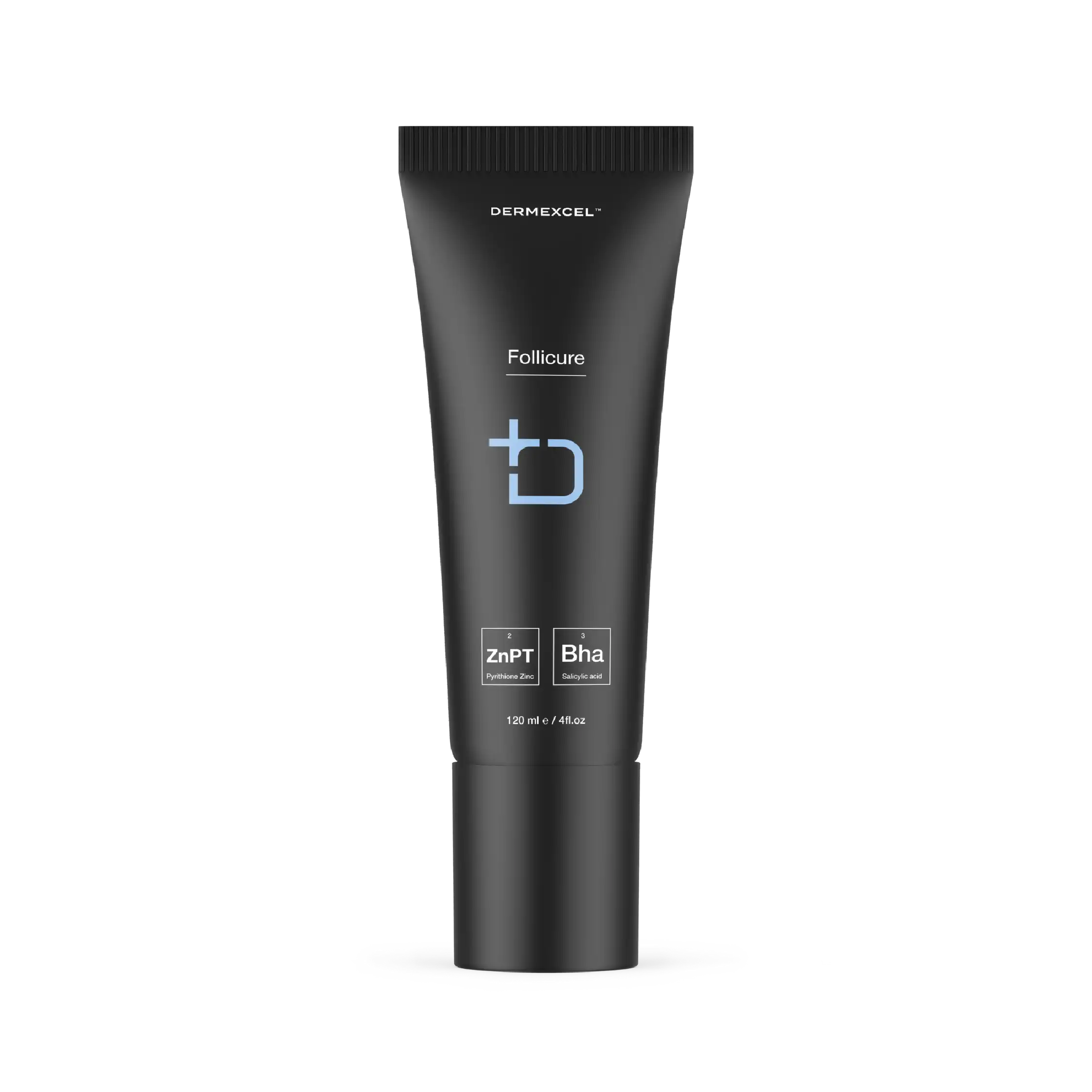
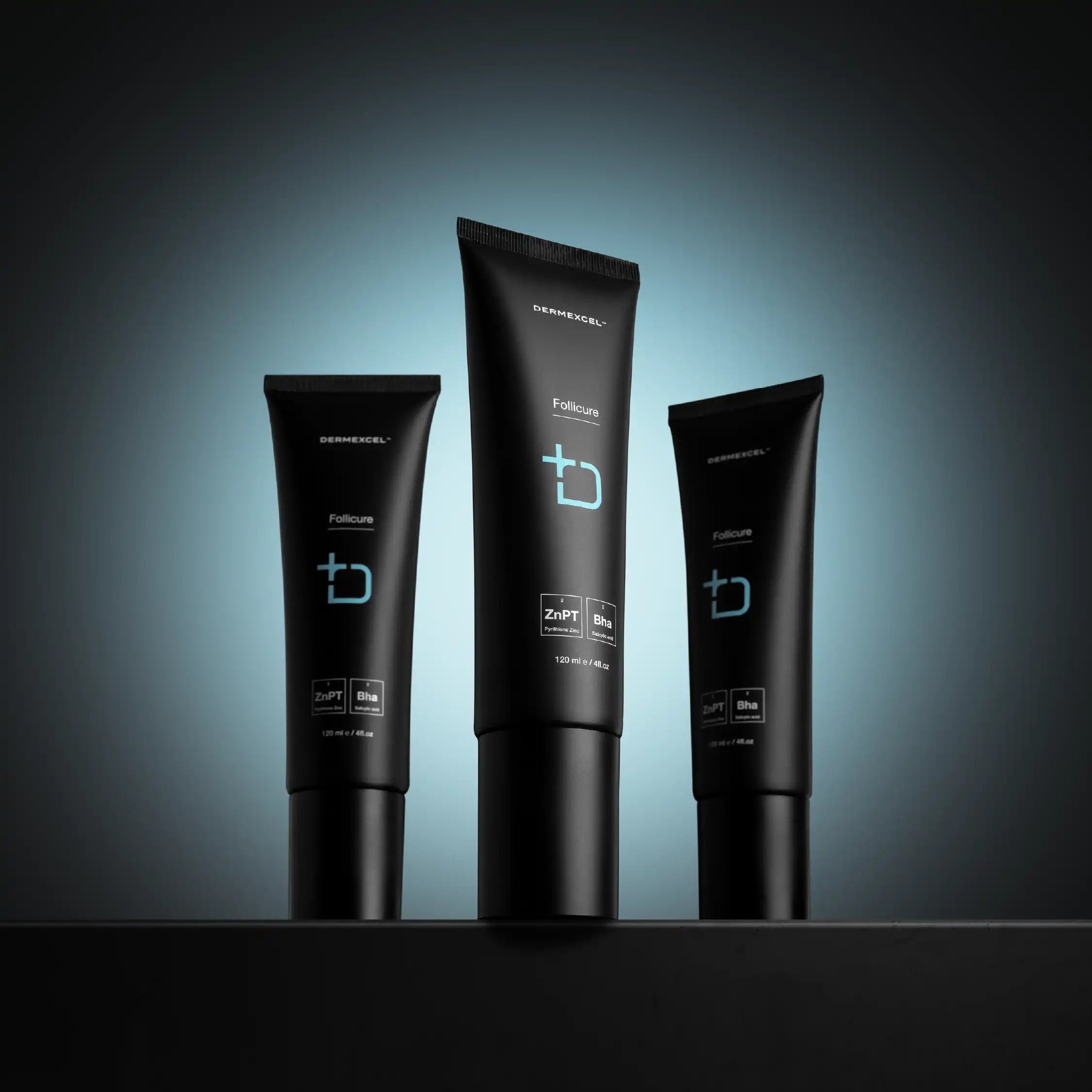




SIZE: 120 mL

healthy scalp

anti-dundruff

↓ inflammation

oil control

Itch Relief
A maximum-strength medicated scalp treatment relieves the itching, irritation, redness, flaking, and scaling associated with dandruff and seborrheic dermatitis.
A powerful formula that combines 2% Salicylic acid and 2% Zinc Pyrithione for maximum effectiveness and life-changing results.
Zinc Pyrithione, an antifungal, antimicrobial, and antibacterial agent, works by reducing the amount of fungus that triggers inflammation and scaling. Zinc Pyrithione also treats pityrosporum folliculitis (fungal acne) on the face and other body parts.
Salicylic acid gently exfoliates the scalp, removing dead skin cells and excess oil, contributing to dandruff and itchiness. As a result, it unclogs hair follicles, promoting a healthier scalp environment.
Zinc Pyrithione
Zinc pyrithione, a compound with potent antifungal and antibacterial properties, has established itself as a cornerstone in the treatment of various skin conditions, particularly those involving Malassezia yeast. Its effectiveness against seborrheic dermatitis and dandruff, which are often associated with an overgrowth of Malassezia species, makes it a key ingredient for many dermatological conditions.
Zinc pyrithione’s mode of action is multifaceted, primarily targeting the membrane of fungi and bacteria, thereby disrupting their growth and replication. One of its significant mechanisms involves inhibiting fungal cell membrane transport by blocking the energy production pathway, which is crucial for cell survival.
In Malassezia, yeast, a natural inhabitant of the skin flora, can overgrow and cause conditions like seborrheic dermatitis and dandruff; zinc pyrithione's antifungal action is particularly beneficial. It reduces the yeast population on the skin, thereby alleviating the symptoms associated with its overgrowth, such as flaking, irritation, and redness.
Its efficacy in treating seborrheic dermatitis is attributed to its ability to reduce the Malassezia count, diminish inflammatory responses, and soothe the skin. Similarly, in dandruff, which is often linked to an excess of Malassezia, zinc pyrithione effectively reduces flaking and itchiness, promoting a healthier scalp environment.
The efficacy of zinc pyrithione in the treatment of seborrheic dermatitis and dandruff is well-documented. Its safety profile and efficacy have been confirmed by numerous studies, with significant improvements observed in both scalp and skin conditions following regular use.
Physiological Effects
- Antifungal Activity: It is effective against a range of fungi, including those that cause dandruff and seborrheic dermatitis. Zinc Pyrithione inhibits the division of fungal cells, reducing their proliferation.
- Antibacterial Properties: This compound also exhibits antibacterial activity, making it useful in treating and preventing bacterial skin infections.
- Anti-inflammatory Effects: Zinc Pyrithione can reduce inflammation, which is beneficial in alleviating symptoms of various inflammatory skin conditions.
- Sebum Regulation: It helps in regulating sebum production, which can be beneficial for oily skin and conditions like acne.
Managing Dermatological Conditions
- Dandruff and Seborrheic Dermatitis: Zinc Pyrithione is a common ingredient in anti-dandruff shampoos and is effective in controlling the flaking and itching associated with these conditions.
- Psoriasis: It can help manage the symptoms of psoriasis, particularly in reducing scaling and redness.
- Acne: Due to its antibacterial and anti-inflammatory properties, Zinc Pyrithione can be beneficial in the treatment of acne.
- Fungal Infections: It is effective in treating various fungal skin infections due to its antifungal properties.
References
- Warshaw, E. M., et al. (2005). Efficacy of Zinc Pyrithione in Seborrheic Dermatitis and Dandruff. Dermatology.
- Pierard-Franchimont, C., et al. (2002). Antidandruff shampoo efficacy in dandruff/seborrhoeic dermatitis. International Journal of Cosmetic Science.
- Scheman, A., et al. (2000). Antimicrobial Activity of Zinc Pyrithione. American Journal of Infection Control.
Salicylic acid
Salicylic acid, a renowned beta hydroxy acid (BHA), is a cornerstone in dermatology and skincare due to its exceptional keratolytic and comedolytic properties. Its unique ability to penetrate oil-laden hair follicle pores makes it particularly effective in treating acne-prone and oily skin types.
Salicylic acid dissolves skin debris (sebum and dead skin cells) that clogs pores and causes acne. It's a mild antibacterial and powerful anti-inflammatory agent that helps reduce the redness and swelling associated with breakouts.
What sets salicylic acid apart in dermatological treatments is its ability to exfoliate the skin, not just on the surface but within the pores themselves. This is due to its oil-soluble nature, which allows it to penetrate deep into the pores and dissolve the keratin plugs that lead to blackheads and whiteheads.
Furthermore, salicylic acid also has the capacity to adjust the pH of the skin, creating an environment less favorable for the growth of acne-causing bacteria. Salicylic acid's efficacy in treating various skin conditions, particularly acne, has been extensively documented in the scientific literature. Studies have consistently shown its ability to reduce acne lesions in terms of count and severity. Additionally, Salicylic acid is highly recommended for its effectiveness in treating other skin conditions, such as psoriasis and dandruff, due to its ability to soften and remove scales and flakes from the skin.
Physiological Effects
- Keratolytic Action: Salicylic acid is known for its ability to exfoliate the skin by dissolving the intercellular 'glue' that holds skin cells together, helping to remove dead skin cells and unclog pores.
- Comedolytic Effect: It is particularly effective in reducing comedones (blackheads and whiteheads) by unclogging pores and preventing the formation of new comedones.
- Anti-inflammatory Properties: Salicylic acid reduces inflammation, which is beneficial in treating acne and other inflammatory skin conditions.
- Sebum Regulation: It helps to regulate oil production, making it a valuable ingredient for managing oily and acne-prone skin.
- Penetration Enhancement: Due to its lipophilic nature, it can penetrate sebum-filled follicles, effectively treating acne located deep within the pores.
Managing Dermatological Conditions
- Acne Vulgaris: Salicylic acid is a cornerstone in acne treatment, effectively preventing and treating existing acne lesions.
- Psoriasis: Its keratolytic properties make it helpful in softening and removing scales associated with psoriasis.
- Warts: Salicylic acid is commonly used to treat warts because it can exfoliate and remove the thickened skin.
- Seborrheic Dermatitis: It helps manage seborrheic dermatitis by reducing scaling and redness.
- Keratosis Pilaris: Salicylic acid can aid in smoothing the rough bumps associated with keratosis pilaris.
References
- Zaenglein, A. L., Pathy, A. L., Schlosser, B. J., Alikhan, A., Baldwin, H. E., Berson, D. S., & Thiboutot, D. M. (2016). Guidelines of care for the management of acne vulgaris. Journal of the American Academy of Dermatology, 74(5), 945-973.e33.
- Kornhauser, A., Coelho, S. G., & Hearing, V. J. (2010). Applications of hydroxy acids: classification, mechanisms, and photoactivity. Clinical, cosmetic and investigational dermatology, 3, 135.
- Zander, E., & Weisman, S. (1992). Treatment of acne vulgaris with salicylic acid pads. Clinical Therapeutics.
- Gupta, A. K., & Nicol, K. (2004). The use of sulfur in dermatology. Journal of Drugs in Dermatology.
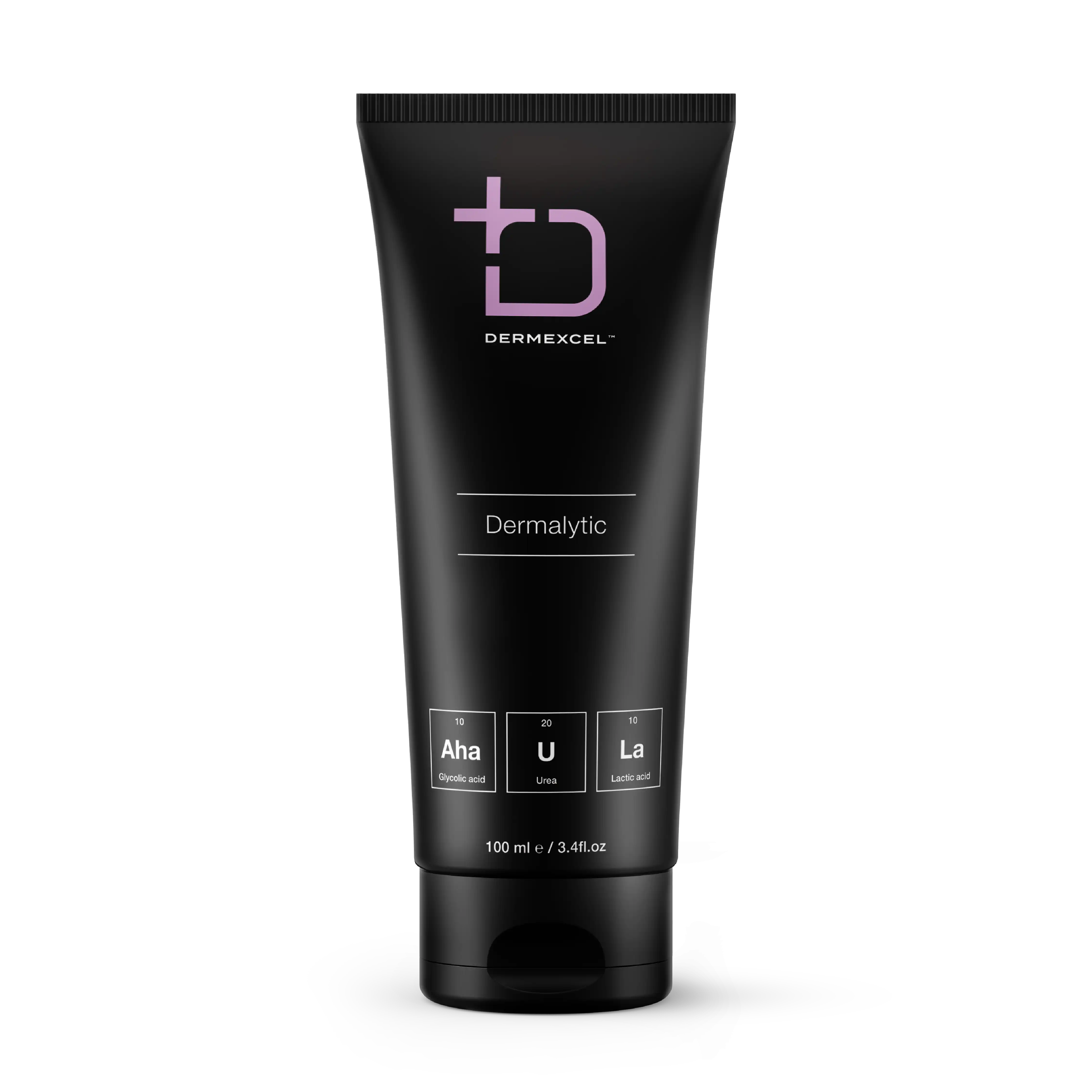
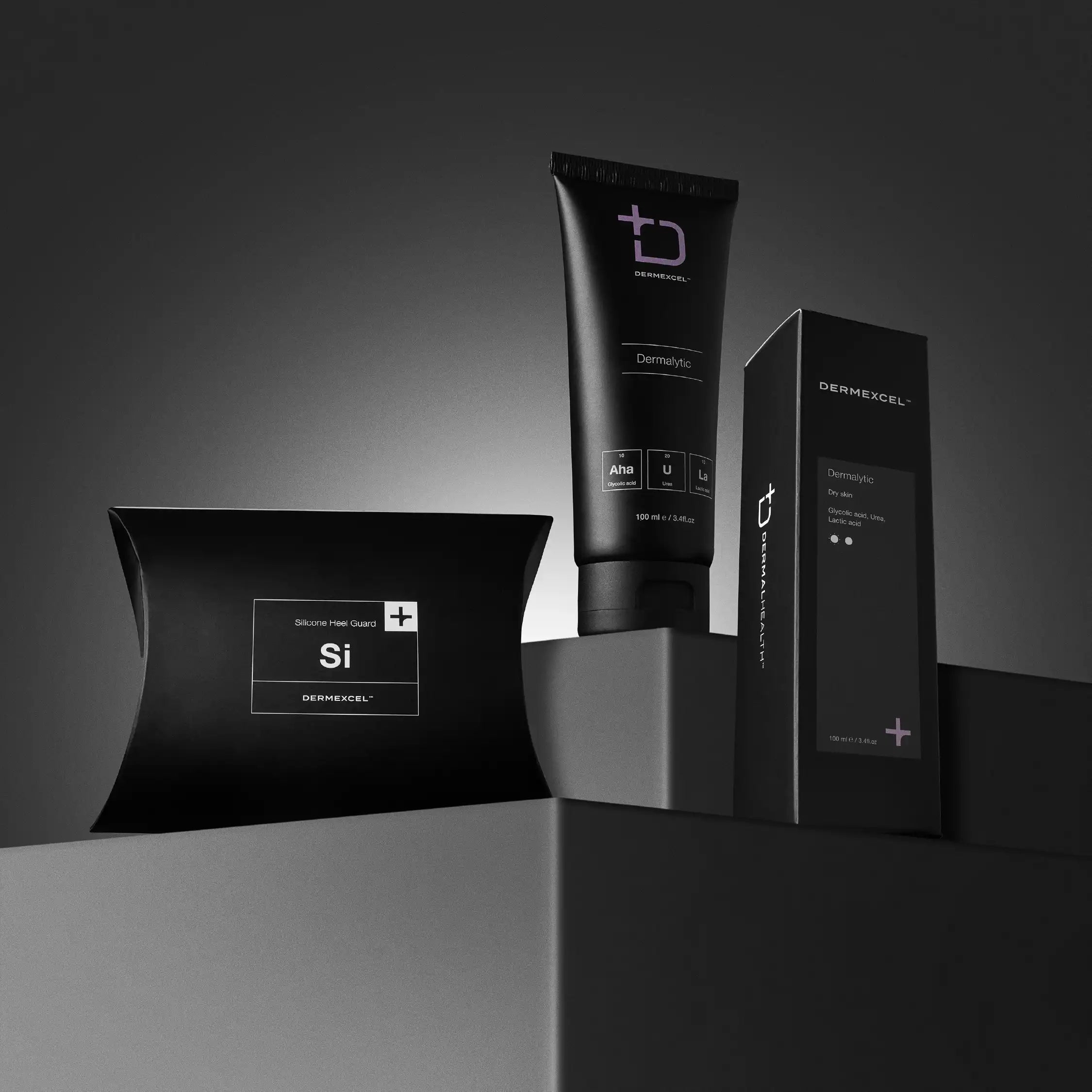






Ingrown hair

Body Acne

Keratosis Pilaris

Rough Skin

cracked heels
A potent and clinically formulated ointment that effectively treats calloused, rough, and dry skin. It's more than a standard moisturizer; it exfoliates dead skin cells and replenishes moisture. The product creates an optimal environment for skin health, leading to a smoother complexion.
Key ingredients include 10% Glycolic acid for exfoliation, 10% Lactic acid for removing dead cells, and 20% Urea for lasting hydration. Its "cream-ointment" base balances efficacy and application comfort. Dermalytic's medical-grade formula and scientific skincare approach visibly improve skin texture, giving users a renewed sense of confidence and comfort.
Note: Dermalytic is too potent for facial use.
Glycolic acid
Glycolic acid is highly acclaimed for its remarkable exfoliating and rejuvenating properties. Its small molecular size enables deep skin penetration, fostering efficient exfoliation at the cellular level.
Glycolic acid’s water solubility allows it to penetrate the upper layers of the skin easily. Its primary mechanism of action involves weakening the bonds between dead skin cells, promoting their shedding, and revealing the newer, healthier skin beneath. This process of accelerated cell turnover is instrumental in addressing a range of skin concerns, from aging signs like fine lines and wrinkles to texture irregularities and hyperpigmentation.
Glycolic acid's efficacy extends beyond mere exfoliation. It's also recognized for stimulating collagen production, a crucial protein in maintaining skin's elasticity and firmness. This aspect contributes to its anti-aging benefits. Furthermore, its hydrating properties add to its appeal, as they help increase the skin's capacity to retain moisture, leading to a more supple and vibrant complexion.
Clinical studies have consistently supported glycolic acid's role in improving skin appearance. Research indicates significant improvements in skin texture and pigmentation and the visible reduction of wrinkles and fine lines with glycolic acid.
Physiological Effects
- Exfoliation: Glycolic acid is a powerful exfoliant. It dissolves the bonds between dead skin cells on the skin’s surface, facilitating their removal and revealing newer, healthier skin underneath.
- Increased Collagen Production: It stimulates collagen production, which is essential for skin elasticity and firmness. This action helps reduce the appearance of fine lines and wrinkles.
- Enhanced Skin Hydration: Glycolic acid improves the skin's ability to retain moisture, enhancing hydration and a more plump, vibrant skin appearance.
- Skin Brightening: Removing dead skin cells can brighten the complexion and reduce the appearance of dark spots and hyperpigmentation.
- Improved Skin Texture: Regular use of glycolic acid can lead to smoother, more even textured skin, making it beneficial for conditions like keratosis pilaris.
- Acne Treatment: Its exfoliating properties help in unclogging pores, thereby reducing the occurrence of acne breakouts.
Managing Dermatological Conditions
- Aging Skin: Glycolic acid is widely used in anti-aging products to reduce signs of aging, such as fine lines, wrinkles, and age spots.
- Acne-Prone Skin: It helps manage acne by exfoliating the skin and removing blockage from pores.
- Hyperpigmentation: It effectively treats hyperpigmentation by accelerating the removal of hyperpigmented skin cells.
- Textural Irregularities: Glycolic acid can improve skin texture and is beneficial for treating keratosis pilaris and other conditions of rough skin.
- Sun-Damaged Skin: It helps rejuvenate sun-damaged skin by accelerating cell turnover and collagen synthesis.
References
- Bernstein, E. F. (2001). Glycolic acid treatment increases type I collagen mRNA and hyaluronic acid content of human skin. Dermatologic Surgery.
- Kornhauser, A., Coelho, S. G., & Hearing, V. J. (2010). Applications of hydroxy acids: classification, mechanisms, and photoactivity. Clinical, Cosmetic and Investigational Dermatology.
- Sharad, J. (2013). Glycolic acid peel therapy – a current review. Clinical, Cosmetic and Investigational Dermatology.
- Smith, W. P. (1996). Epidermal and dermal effects of topical lactic acid. Journal of the American Academy of Dermatology, 35(3), 388-391.
Urea
Urea, a naturally occurring compound in the skin, is widely recognized in dermatology and skin care for its hydrating and keratolytic properties. It is a component of the skin's natural moisturizing factor (NMF) and is crucial in maintaining skin hydration and barrier function.
In skin care, urea is valued for its dual action: it acts as a humectant, drawing moisture into the skin, and as a keratolytic agent, helping to break down the protein bonds between dead skin cells, leading to smoother and softer skin. This makes it particularly effective in treating dry, rough, and scaly skin conditions such as eczema, psoriasis, and ichthyosis.
Additionally, urea has been shown to have antimicrobial properties and can aid in skin barrier repair, further underscoring its utility in treating various skin conditions.
Physiological Effects
- Hydration: Urea is a potent humectant, meaning it draws moisture into the skin, significantly improving hydration and maintaining skin moisture balance.
- Keratolytic Action: Urea has keratolytic properties, helping to break down the bonds between dead skin cells and aiding in the exfoliation of the skin's surface.
- Skin Barrier Function: Urea enhances the skin's barrier function, helping to prevent moisture loss and protect the skin from external irritants.
- Soothing Effect: It soothes dry, itchy, and irritated skin, providing relief from various skin conditions.
Managing Dermatological Conditions
- Dry Skin (Xerosis): Urea is a key ingredient in many moisturizers for treating dry skin due to its excellent hydrating properties.
- Eczema and Psoriasis: It helps manage symptoms like dryness, scaling, and itching in eczema and psoriasis.
- Ichthyosis and Keratosis Pilaris: The keratolytic action of urea makes it effective in conditions characterized by excessive skin scaling, such as ichthyosis and keratosis pilaris.
- Cracked Heels and Calluses: Urea-based creams effectively soften and reduce thickened skin on heels and calluses.
- Aging Skin: It can improve skin texture and hydration in aging skin.
References
- Lodén, M. (2003). Role of topical emollients and moisturizers in the treatment of dry skin barrier disorders. American Journal of Clinical Dermatology.
- Pan, M., et al. (2013). Efficacy of topical urea in the treatment of xerosis. American Journal of Clinical Dermatology.
- Fluhr, J. W., et al. (2008). Glycerol and the skin: holistic approach to its origin and functions. British Journal of Dermatology.
- Grether-Beck, S., Felsner, I., Brenden, H., Kohne, Z., Majora, M., Marini, A., ... & Krutmann, J. (2012). Urea uptake enhances barrier function and antimicrobial defense in humans by regulating epidermal gene expression. Journal of Investigative Dermatology, 132(6), 1561-1572.
Lactic acid
Lactic acid, a member of the alpha hydroxy acid (AHA) family, is a well-regarded ingredient in the field of dermatology and skincare for its exfoliating and moisturizing properties. Naturally occurring in sour milk and other fermented products, lactic acid is also produced in the human body and plays a role in various metabolic processes.
In skincare, lactic acid is primarily known for its ability to exfoliate the skin gently. By breaking down the bonds that hold dead skin cells together on the skin's surface, lactic acid helps to promote the shedding of these cells, revealing fresher, brighter skin underneath. This exfoliation process improves skin texture and tone and stimulates cell renewal.
One key advantage of lactic acid over other AHAs is its moisturizing capability. Lactic acid helps increase the skin's natural moisturizing factors (NMF), essential for keeping the skin hydrated. Its unique ability to draw moisture into the skin is particularly beneficial for treating dry and dehydrated skin conditions.
Physiological Effects
- Exfoliation: A gentle exfoliant that removes dead skin cells from the skin's surface, promoting smooth skin.
- Moisture Retention: It is a humectant that helps the skin retain moisture, improving hydration and reducing dryness.
- Collagen Stimulation: Lactic acid can stimulate collagen production in the deeper layers of the skin, aiding in skin firmness and reducing the appearance of fine lines and wrinkles.
- Skin Brightening: It helps lighten dark spots and even out skin tone, effectively treating hyperpigmentation.
- pH Balancing: Lactic acid can help balance the skin's natural pH levels, which is beneficial for maintaining a healthy skin barrier.
Managing Dermatological Conditions
- Aging Skin: Lactic acid's collagen-stimulating and exfoliating properties make it effective in anti-aging treatments, reducing signs of aging like wrinkles and age spots.
- Acne-Prone Skin: By unclogging pores and removing dead skin cells, lactic acid can help reduce acne breakouts.
- Dry Skin (Xerosis): Its humectant properties are beneficial in hydrating and relieving dry skin.
- Hyperpigmentation: Lactic acid treats hyperpigmentation issues, including melasma and sun damage.
- Keratosis Pilaris: It can help manage keratosis pilaris by exfoliating the excess keratin that blocks hair follicles.
References
- Smith, W. P. (1996). Epidermal and dermal effects of topical lactic acid. Journal of the American Academy of Dermatology.
- Kornhauser, A., Coelho, S. G., & Hearing, V. J. (2010). Applications of hydroxy acids: classification, mechanisms, and photoactivity. Clinical, Cosmetic and Investigational Dermatology.
- Stiller, M. J., et al. (1996). Topical 8% glycolic acid and 8% L-lactic acid creams for the treatment of photodamaged skin. A double-blind vehicle-controlled clinical trial. Archives of Dermatology.
- Rawlings, A. V., Davies, A., Carlomusto, M., Pillai, S., Zhang, K., Kosturko, R., ... & Watson, D. (1996). Effect of lactic acid isomers on keratinocyte ceramide synthesis, stratum corneum lipid levels and stratum corneum barrier function. Archives of Dermatological Research, 288(7), 383-390.
Testimonials
An amazing product. I saw a huge improvement within 2 weeks. I'm so grateful to Dermalhealth not just for the product but also for their exceptional service and helpful advice.
Worked wonders for my KP. They are a lot less noticeable. Would recommend.
Treatment pack: Acne
Great product!My daughters skin has improved overall. The hype is real.Really good quality, lovely packaging & Speedy delivery.
Isotretinoin Enhancement pack
Most amazing product ever!












